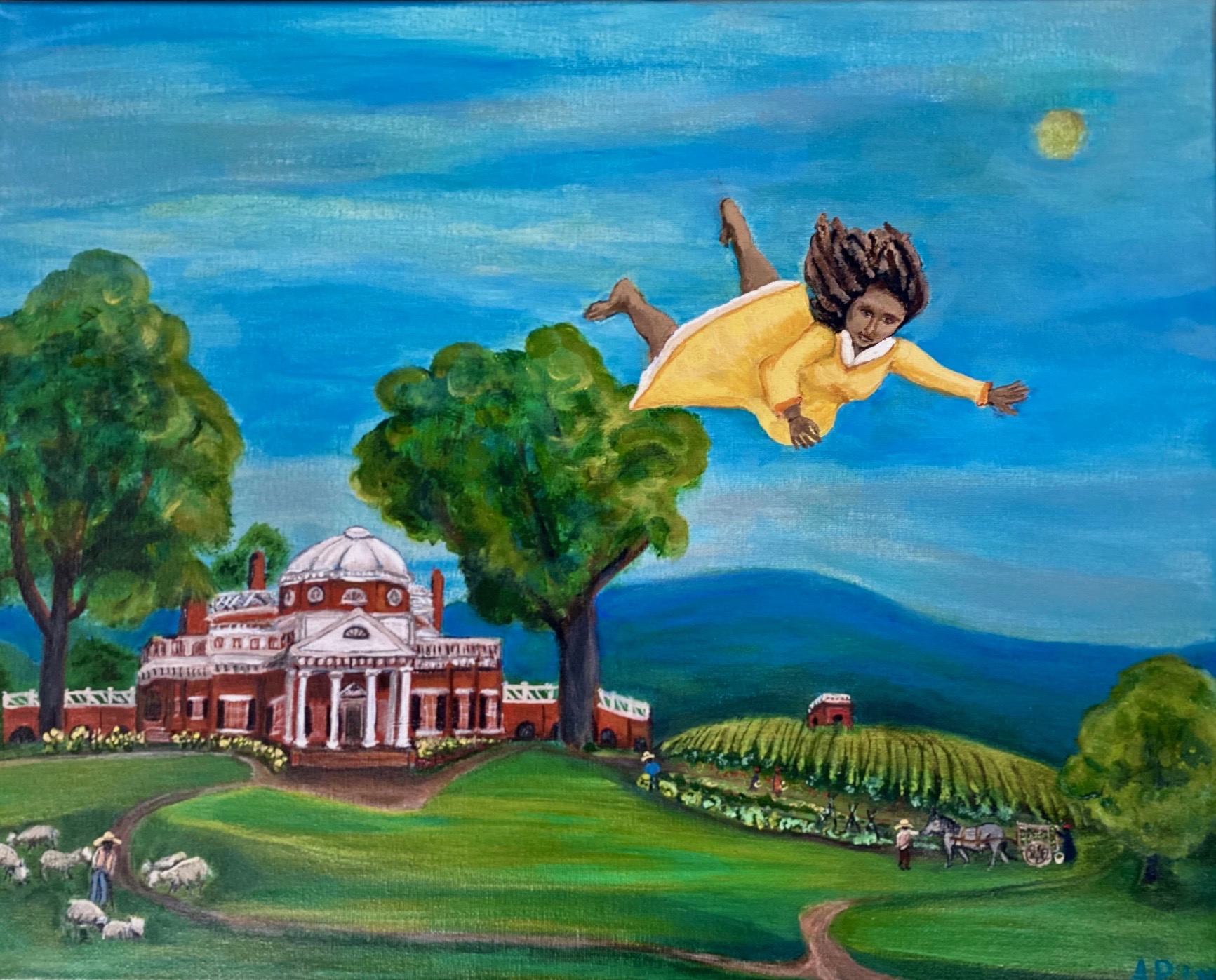A Dream I Had
By Amy Satterthwaite Pappas
A teenage girl falls fast asleep in the summer of 1789. Her strong body is capable of nearly anything—has experienced nearly everything already—but the demands of her first pregnancy deplete her. In the heat of the day, she lies back on her straw mattress and shuts her eyes.
She dreams. At age 16, she’s still young enough to fly easily in her dreams; none of the huffing and puffing and flailing of arms it takes a dreaming adult to lift off the ground. She is free when aloft in her dreams. But only then.
This is how I paint Sally Hemings. Floating above familiar fields and faces and away down the Little Mountain. Heavily pregnant with the first of at least six children she will bear her owner, Thomas Jefferson. He is 46; just home from Paris with Sally and his two daughters after serving as ambassador to France. He won’t be president for another 12 years.
My composition is presumptuous. A daydreaming amateur artist taking up her acrylics to paint her subject’s fantastical dream.
And just where does young Sally think she’s flying off to?
Unless she can make it all the way to Canada, she might as well turn around. America in the 1700s is no place for a lone Black girl. Though three of her four grandparents are white, Sally’s mother is enslaved. Therefore by law so are Sally and her siblings. She stands little chance off Jefferson’s mountaintop farm. Even in the Northern states, roving bands of men kidnap Black people, rip up their free papers if they exist, and sell them way down South, where they’ll be worked until they die.
If Sally didn’t leave Jefferson when she had the opportunity and the law on her side in Paris, she is a low risk to run away in Charlottesville now. Monticello is the only home she’s ever known. Her mother, Betty, is here. And who among us doesn’t need her mother when pregnant for the first time?
Her beloved sister, Critta, shares a bed with Sally.
Soon Sally will leave the cabins of Mulberry Row, where most of Monticello’s enslaved workers live, for more spacious quarters. Eventually she and her light-skinned children will have rooms in the south wing of the main dwelling, befitting their favored status.
“It was Mother’s duty up until Father’s death to take care of his chambers and wardrobe, look after us children and do light work such as sewing,” Madison Hemings will remember years later. “And we were always permitted to be with our mother, only running errands when we were children.”
“Mother” was Sally Hemings; “Father” was Thomas Jefferson.
Four of Sally and Tom’s children live to adulthood. The eldest two, son Beverly and daughter Harriet, are freed at 21. They are so light-skinned they pass as white and marry into white families. Neither acknowledges where they are from, and neither ever returns to Monticello.
The youngest two, sons Madison and Eston, are also freed at 21. “We all became free agreeably to the treaty entered into by our parents before we were born,” Madison will say. He and Eston live as free Blacks in Charlottesville. Sally comes down the mountain to live with them after Jefferson dies.
Her grave is here in town, but no one can find it. I wonder how hard they’ve looked. It should be a landmark. Her statue should stand in City Park downtown, in the space left by removal of the giant statue of Robert E. Lee that caused us all so much trouble.
I’m always going up the hill to Monticello. I like to take a sketchbook and sit under the old linden trees, where I attempt to draw all those corners and columns, porticos and pavilions. In the afternoons, I listen to the actor who portrays Jefferson while he stands on the west lawn and answers questions for the tourists.
“Did you love Sally Hemings?” I once blurt out to this Jefferson. He demurs and tells me my question is impertinent. He says, “A gentleman keeps affairs of the heart to himself.”
I let that one go. But I have another question and blurt that out, too, in front of the tourists. “Do you ever regret promising your wife on her deathbed that you would never marry again?”
The actor launches into why the real Jefferson was said to have made the vow: Because his wife, Martha, had lost her own mother in childhood and had been raised by a cruel stepmother. She feared the same fate for her own children.
But the actor misses my point. If Jefferson had felt free to remarry, would he have left young Sally Hemings alone? Because the famous widower didn’t stay away from Sally Hemings for the last 37 years of his long life.
I considered including Thomas Jefferson in my painting, maybe riding out on his big stallion Caractacus in the green foreground. But this is Sally’s dream. And mine. Here she gets to fly alone.
***
Amy Satterthwaite Pappas lived and wrote and raised two children in Fredericksburg, Virginia, before moving back home to the Charlottesville area in 2010. She fools around with writing and painting when she’s not fighting the wild woods from taking over her Crozet property.


